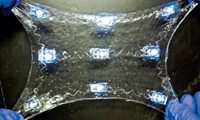Advertisement
Grab your lab coat. Let's get started
Welcome!
Welcome!
Create an account below to get 6 C&EN articles per month, receive newsletters and more - all free.
It seems this is your first time logging in online. Please enter the following information to continue.
As an ACS member you automatically get access to this site. All we need is few more details to create your reading experience.
Not you? Sign in with a different account.
Not you? Sign in with a different account.
ERROR 1
ERROR 1
ERROR 2
ERROR 2
ERROR 2
ERROR 2
ERROR 2
Password and Confirm password must match.
If you have an ACS member number, please enter it here so we can link this account to your membership. (optional)
ERROR 2
ACS values your privacy. By submitting your information, you are gaining access to C&EN and subscribing to our weekly newsletter. We use the information you provide to make your reading experience better, and we will never sell your data to third party members.
ACS Meeting News
New hydrogel materials could help repair tissue
Researchers have designed an injectable granular hydrogel that may help heal tissue
by Fionna Samuels
August 22, 2024

Hydrogels are often used as scaffolds in tissue engineering. Living cells infused into the material can, theoretically, grow through the gel until an entire piece of tissue forms. But to grow well, cells need to interact with one another. Unfortunately, traditional hydrogel scaffolds don’t allow much cell-to-cell interaction. Granular hydrogels could overcome this issue.
Instead of one uniform hydrogel, granular hydrogels are composed of many micrometer-sized subunits that are simply packed together, said Jason Burdick, a bioengineer at the University of Colorado Boulder. In part of a presentation given Wednesday to the American Chemical Society Division of Polymeric Materials: Science and Engineering at the ACS Fall 2024 meeting, Burdick discussed the work of graduate student Nikolas Di Caprio, which leverages the unique properties of granular hydrogels to bioengineer cartilage tissue.

The trick, Burdick told C&EN, is to mix clusters of cells into the granular hydrogel to make a composite material (Adv. Mater. 2024, DOI: 10.1002/adma.202312226). This allows the cells to interact with one another while also giving them the structural stability of the hydrogel.
The space between the material’s subunits allows the gel to flow, making it injectable, but it also creates pockets of space where the cartilage cell clusters can expand. “The reason we end up getting such great cartilage is that I think we’re just building from cell environments that the cells really like,” Burdick said.
Of course, the material can’t flow indefinitely. After it’s injected into a joint or mold, Burdick said, “we want to kind of click these particles together to stabilize it into that structure.” That’s done by shining a light on the granular gel for 3 min. The tiny hydrogel spheres are composed of norbornene-modified hyaluronic acid and, under the light, the norbornene groups cross-link with adjacent hydrogel spheres through a dithiol cross-linker.
The work presented “combines two areas that Jason has really been a pioneer in, that being cartilage tissue engineering and microgels,” said Kent Leach, a biomedical engineer at the University of California, Davis. “I think it’s elegant.”
UPDATE:
This story was updated on Aug. 22, 2024, to restore a missing second paragraph introducing Jason Burdick and Nikolas Di Caprio, which was omitted because of a production error.





Join the conversation
Contact the reporter
Submit a Letter to the Editor for publication
Engage with us on Twitter